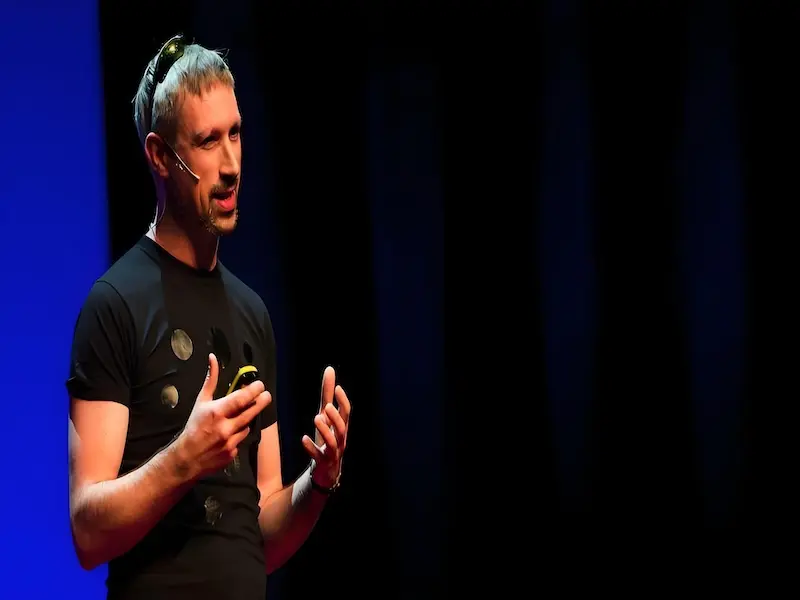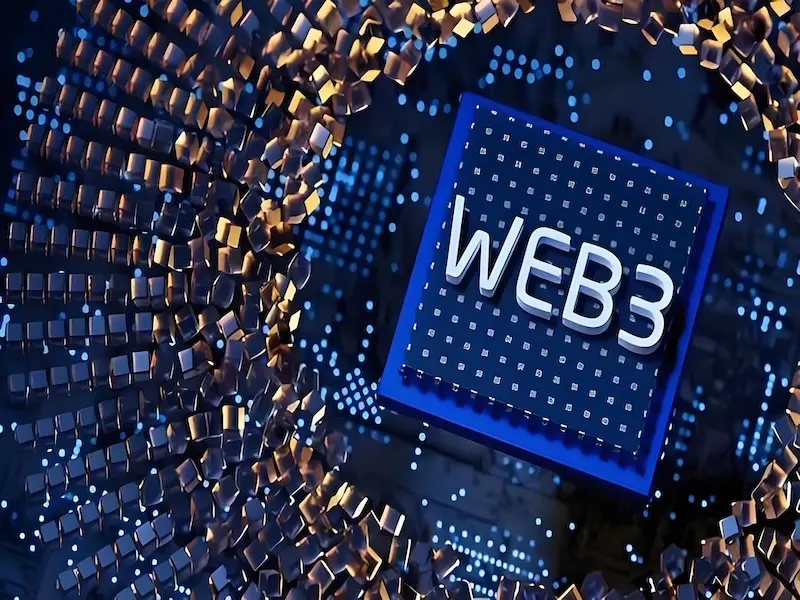- Gavin Wood, founder of blockchain infrastructure company Parity Technologies, coined the term “Web 3.0” in 2014, laying out his vision of the future of the internet.
- Web3 is a term used to describe the vision of a decentralised internet built on blockchain technology.
- Web3 represents a paradigm shift towards a more open, transparent, and user-centric internet, but it’s still an evolving concept with many technical and regulatory challenges to overcome.
Web 3 represents the next evolution of the internet, where users have more control over their data and digital identities, and where peer-to-peer interactions are facilitated through decentralised protocols rather than centralised entities.
Who is Gavin Wood?
Gavin James Wood is an English computer scientist, a co-founder of Ethereum, the second-largest cryptocurrency platform by market capitalization after Bitcoin. He coined the term “Web 3.0” in 2014 to articulate his vision for the future of the Internet.
Before working on Ethernet, Wood was a research scientist at Microsoft. Along with Vitalik Buterin, Charles Hoskinson, Anthony Di Iorio, and Joseph Lubin, he described it as “a computer for the entire planet” between 2013 and 2014.
Wood proposed and helped develop Solidity, a programming language for writing smart contracts. He also released the paper defining the Ethereum Virtual Machine, the runtime system for smart contracts in Ethereum, in 2014.
In addition to his work on Ethereum, Wood is the founder and former CTO of Parity Technologies, a blockchain infrastructure company known for developing the Parity Ethereum client, as well as other blockchain-related projects.
Beyond Ethereum, Wood has been involved in various blockchain and decentralized technology initiatives. He is one of the founders of the Web3 Foundation, which supports the development and adoption of decentralized web technologies. Wood is also the creator of Polkadot, a blockchain interoperability protocol designed to connect multiple blockchains into a single network, enabling them to share information and assets securely.
According to an interview with Wood on CNBC, he states that “Web3 is sort of an alternative vision of the web, where the services that we use are not hosted by a single service provider company, but rather they’re sort of purely algorithmic things that are, in some sense, hosted by everybody. So it’s like, it’s very peer-to-peer, right? … The idea is that all participants sort of contribute a small slice of the ultimate service.”
“And thus, no one has any advantage over anyone else … not in the same sense,” he added. For Wood, Web3 is truly decentralised, a more democratic version of the current Internet.

What is Web3
In Web3, blockchain technology plays a central role in enabling decentralization. Blockchains are distributed ledgers that record transactions across a network of computers transparently and securely.
They enable trustless interactions, meaning that users can transact directly with each other without the need for intermediaries.
Here are some key concepts associated with Web3.
Decentralised Applications (DApps): these are applications built on blockchain platforms that operate without a central authority. They often leverage smart contracts, which are self-executing contracts with the terms of the agreement directly written into code.
Cryptocurrencies and Tokens: digital currencies like Bitcoin and Ethereum are integral to Web3, facilitating peer-to-peer transactions and powering decentralised applications. Tokens are digital assets issued on blockchain networks, representing ownership or access rights.
Decentralised Finance (DeFi): DeFi refers to the use of blockchain technology and cryptocurrencies to recreate traditional financial systems such as lending, borrowing, and trading without intermediaries like banks or brokers.
Self-Sovereign Identity: Web3 envisions a future where individuals have control over their digital identities and personal data, allowing them to manage and share information securely and privately.
Interoperability: in the Web3 vision, different blockchain networks and decentralised applications should be able to communicate and interact seamlessly, enabling a more connected and interoperable ecosystem.
Web3 represents a paradigm shift towards a more open, transparent, and user-centric internet, where individuals have greater sovereignty over their digital lives.
However, it’s still an evolving concept with many technical and regulatory challenges to overcome.
Also read: Web3 startups turn to accelerators in new crypto bull market
How is Web3 different from Web2 and Web1
Web3, Web2, and Web1 represent different stages in the evolution of the internet, each characterized by distinct features, technologies, and user experiences.
Web1, also known as the “read-only” web, refers to the early days of the internet, primarily the 1990s and early 2000s.
It was characterised by static websites with limited interactivity. Users could access information but had little ability to contribute or interact with content.
Web1 was primarily focused on information dissemination, with websites serving as digital brochures or repositories of static content.
Examples of Web1 technologies include HTML, early versions of HTTP, and basic web browsers like Netscape Navigator and Internet Explorer.
Web2, often referred to as the “read-write” web, emerged in the mid-2000s and continues to dominate the internet landscape today.
It introduced dynamic, interactive web experiences, driven by user-generated content, social media, and collaborative platforms.
Web2 is characterised by social networking sites, blogging platforms, video-sharing platforms, and other interactive web applications that enable users to create, share, and interact with content.
Examples of Web2 technologies include social media platforms like Facebook, Twitter, and Instagram, as well as content management systems like WordPress and blogging platforms like Medium.
Compared with the previous two, Web3 emphasises the next stage in the evolution of the internet, characterised by decentralisation, blockchain technology, and user sovereignty.
It aims to address the limitations of previous iterations of the web, such as centralised control, data privacy concerns, and reliance on intermediaries.
Web3 represents a paradigm shift towards a more decentralised, user-centric internet, building upon the foundations laid by Web1 and Web2 while introducing new technologies and concepts aimed at empowering individuals and fostering greater transparency, privacy, and interoperability online.
Also read: Blockchain Expo North America 2024: Latest in Web3, NFTs, crypto
Regulatory issues for Web3
Although Web3 is seen as the future of the Web, regulatory issues for Web3, spelled with British spelling, entail a range of challenges and considerations as this decentralized paradigm intersects with existing legal frameworks and regulatory environments.
Here are some key regulatory issues.
Cryptocurrency Regulation: cryptocurrencies, which play a central role in Web3, are subject to varying degrees of regulation around the world.
Governments and regulatory bodies are grappling with how to classify and regulate cryptocurrencies, including concerns related to consumer protection, anti-money laundering (AML), and combating the financing of terrorism (CFT).
Token Regulation: The tokens issued on blockchain networks, whether as digital assets, utility tokens, or security tokens, raise questions about regulatory classification and compliance.
Regulatory clarity is needed to determine whether tokens fall under securities regulations, commodity regulations, or other regulatory frameworks, and to ensure that token issuers comply with applicable laws.
Smart Contract Regulation: smart contracts, which are self-executing contracts with the terms of the agreement directly written into code, raise legal questions related to contract enforceability, liability, and dispute resolution.
Regulatory guidance is needed to address these issues and ensure that smart contracts are legally enforceable and compliant with existing laws.
Data Protection and Privacy: Web3’s emphasis on decentralisation and user sovereignty raises questions about data protection and privacy.
Regulatory frameworks such as the General Data Protection Regulation (GDPR) in the European Union impose strict requirements on the collection, processing, and storage of personal data, which may pose challenges for Web3 applications and platforms.
Decentralised Finance (DeFi) Regulation: DeFi platforms, which aim to recreate traditional financial services using blockchain technology, face regulatory scrutiny related to securities regulation, consumer protection, and financial stability.
Regulators are seeking to understand and address the risks associated with DeFi, including concerns about fraud, market manipulation, and systemic risk.
Interoperability and Cross-Border Transactions: interoperability between different blockchain networks and cross-border transactions raises jurisdictional challenges for regulators.
Regulatory coordination and harmonisation are needed to address cross-border issues and ensure consistent regulatory treatment of Web3 technologies and applications.
Decentralised Autonomous Organisations (DAOs): DAOs, which are organisations governed by smart contracts and blockchain-based voting mechanisms, raise questions about legal personhood, liability, and accountability.
Regulatory frameworks are needed to clarify the legal status of DAOs and establish governance mechanisms that comply with existing laws.
From the day Wood coined the term “Web 3.0” in 2014, to the present day when web3 is seen as the future of the Internet, Web3 has been striving to be a transformative force in the evolution of the internet, offering a more open, inclusive, and resilient digital ecosystem.

